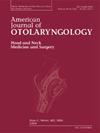Preliminary study on classification and treatment of type I variant preauricular fistula
IF 1.7
4区 医学
Q2 OTORHINOLARYNGOLOGY
引用次数: 0
Abstract
Objective
To classify and manage Type I Variant Preauricular Fistulas (Type I VPFs) based on clinical manifestations, evaluate the efficacy of individualized surgical approaches, and provide a reference for their treatment.
Methods
From January 2016 to December 2023, our department treated 34 cases of Type I VPFs, including 19 males and 15 females, aged 11 months to 12 years (mean age: 5 years and 5 months). Sixteen cases involved the left ear, and 18 involved the right ear, with 4 cases presenting double fistulas. All cases had recurrent infections, and 7 cases had a history of incision and drainage. Based on clinical features, the fistulas were classified into Simple Type I VPFs, Conchal Type I VPFs, Retroauricular Groove Type I VPFs, External Auditory Canal Type I VPFs, and Hybrid Type I VPFs. Surgical management included complete fistula excision with adjacent crus helicis cartilage removal. Auxiliary incisions were made to debride granulation tissue based on its location, and primary flap reconstruction was performed for skin defects.
Results
The distribution of cases was as follows: Simple Type I VPFs (20.59 %, 7/34), Conchal Type I VPFs (35.29 %, 12/34), Retroauricular Groove Type I VPFs (29.41 %, 10/34), External Auditory Canal Type I VPFs (11.76 %, 4/34), and Hybrid Type I VPFs (2.94 %, 1/34). Approximately 29.41 % (10/34) of patients required flap reconstruction for defect repair, with these cases exclusively involving the conchal typeI VPFs.
Conclusion
Classification of Type I VPFs facilitates tailored surgical planning, achieving optimal functional and cosmetic outcomes.
变异型耳前瘘分型及治疗的初步探讨
目的根据临床表现对I型变异性耳前瘘进行分类和处理,评价个体化手术入路的疗效,为其治疗提供参考。方法2016年1月至2023年12月,我科共收治I型vpf 34例,男19例,女15例,年龄11个月~ 12岁,平均5岁5个月。16例累及左耳,18例累及右耳,其中4例出现双瘘。所有病例均有反复感染,其中7例有切口引流史。根据临床特点,将瘘分为单纯型VPFs、耳后沟型VPFs、外耳道型VPFs和混合型VPFs。手术治疗包括完全切除瘘管并切除邻近的腓骨软骨。根据肉芽组织的位置,进行辅助切口清除肉芽组织,对皮肤缺损进行一期皮瓣重建。结果单纯I型VPFs(20.59%, 7/34)、耳道I型VPFs(35.29%, 12/34)、耳后沟I型VPFs(29.41%, 10/34)、外耳道I型VPFs(11.76%, 4/34)和混合型VPFs(2.94%, 1/34)的分布情况为:单纯I型VPFs(20.59%, 7/34)、耳后沟I型VPFs(35.29%, 12/34)。大约29.41%(10/34)的患者需要皮瓣重建来修复缺陷,这些病例仅涉及耳甲型pei vpf。结论I型VPFs的分类有助于制定针对性的手术计划,达到最佳的功能和美容效果。
本文章由计算机程序翻译,如有差异,请以英文原文为准。
求助全文
约1分钟内获得全文
求助全文
来源期刊

American Journal of Otolaryngology
医学-耳鼻喉科学
CiteScore
4.40
自引率
4.00%
发文量
378
审稿时长
41 days
期刊介绍:
Be fully informed about developments in otology, neurotology, audiology, rhinology, allergy, laryngology, speech science, bronchoesophagology, facial plastic surgery, and head and neck surgery. Featured sections include original contributions, grand rounds, current reviews, case reports and socioeconomics.
 求助内容:
求助内容: 应助结果提醒方式:
应助结果提醒方式:


